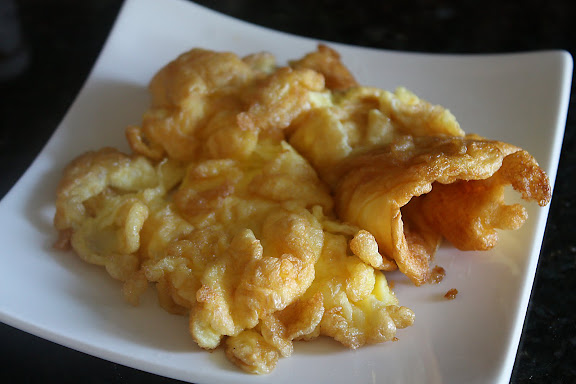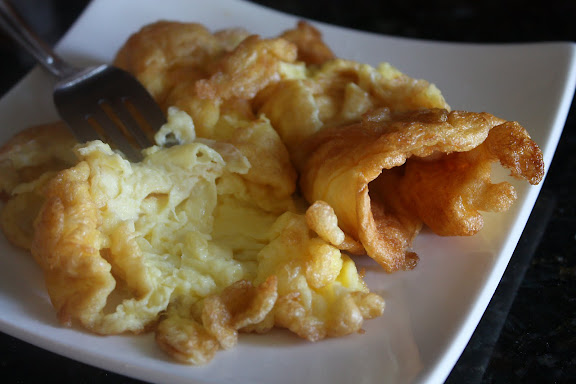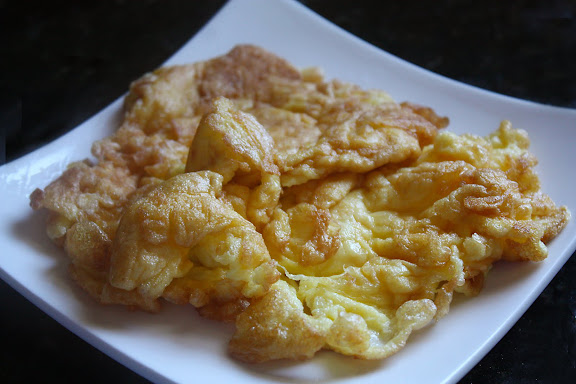
Imagine a bowl of soft and fluffy Jasmine rice. Perfectly cooked. Unadorned. Not piping hot; just a tad warmer than room temperature. Imagine a Thai omelet, a round of soft and fluffy eggy layers, hot and puffy off the wok, with its edges crispy and light as clouds over the rice. Then imagine a blessed anointing of Thai Sriracha on top of it all … My heartbeats are audible as I’m typing this.
From the way I’ve described Khai Jiaw or Khai Jeow, Khai Jiow, Khai Jiao (ไข่เจียว) above, you can see that Thai-style omelets (or omelettes? — maybe I should confuse everybody by alternating between both variants as well as the various Thai spellings in this post?) are so drastically different from their French counterparts. Actually, other than the fact that both are made out of eggs, they have very little in common both in the way they’re made or served. While French omelettes are supposed to be light-colored and soft and creamy all over, Thai omelets are supposed to be fluffy on the inside and crispy on the outside (particularly around the edges).
Then again, as is the case with any given dish, different people have different preferences. My grandmother loved her Khai Jiow soft and a bit oily (but then she liked her coffee at room temperature too …). For one of my cousins, Khai Jiao is not authentic unless it has thinly-sliced shallots added. Some people add herbs or meat (fresh oyster, ground pork, crab meat, etc.) to their Thai omelettes. I like my Khai Jiao plain. And since this is my blog (heh), crispy plain Thai-style omelet is featured here.
Here’s how you make a single serving of crispy Khai Jiaw.
First, a little visual aid.
- 2 large duck or chicken eggs
- 2-3 drops of lime or lemon juice (plain white vinegar works too)
- 1 tablespoon cornstarch, potato starch, or rice flour
- 1 teaspoon of fish sauce
- ¾ cup plain vegetable oil
- Before you do anything, scoop some steamed Jasmine riceonto a serving plate. The omelet cooks very quickly and when it goes out of the wok, it needs a place to land immediately.
- Crack the eggs into a bowl that is big enough to hold twice their volume.
- Add the lime juice and fish sauce to the eggs.
- Meanwhile, get your wok ready. An 8-inch nonstick wok works best here. Heat up the vegetable oil in the wok over high heat.
- Beat the egg mixture with a fork or a small whisk until it is frothy. Your eggs don’t need to be beaten as if you were making sponge cake or sabayon; you just want to get the eggs to be light and airy.
- Beat in the flour; make sure the flour is completely interspersed with the egg mixture for lumps are bad, really bad. (To minimize the risk of lumps, instead of adding the lime juice and fish sauce separately, you can mix both with the flour, adding a teaspoon or so of water if absolutely necessary. Then you beat the mixture into the eggs.)
- Once the oil starts smoking (you must see smoke), it is ready. Add the frothy egg mixture into the hot oil and see how it puffs up before your eyes. If you crave drama in the kitchen, hold the egg bowl about a foot or so above the wok and pour. This will create the milk crown effect which causes your Khai Jiaw to develop jagged edges and asymmetry which lead to more pronounced inner layers and peripheral crispiness. No hardcore splattering should happen, but to be on the safe side, you may want to stand back.
- Count to 20 Mississippis, flip the omelette once (don’t worry if you mess it up while flipping; anything that creates jagged edges and asymmetry works well here), and count another 20 Mississippis. Take the omelet out of the pan and place it on top of the rice. Drizzle some Thai Sriracha sauce (aka not the Rooster sauce) on top if desired and consume immediately.
adsa









79 Responses to Thai-Style Omelets (Khai Jiao, Khai Jeow, Khai Jiaw, ไข่เจียว)